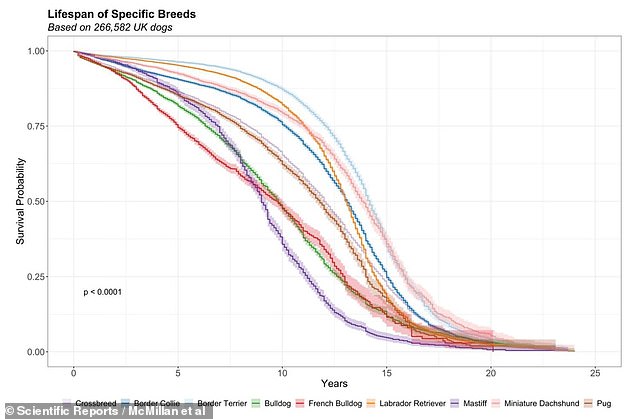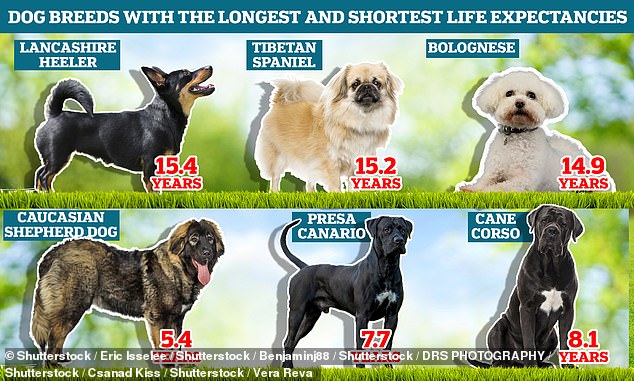Table of Contents
They have long been known as “man’s best friend,” so it’s no surprise that most dog owners dread the thought of the day their pet passes away.
Now, a study shows that when it comes to life expectancy in dogs, there is a huge variation between breeds.
Dogs Trust researchers analyzed more than 580,000 dogs in the UK to understand the effects of breed, body size, face shape and sex on life expectancy.
The findings may sound the alarm for owners of Caucasian sheepdogs, Presa Canarios and Cane Corsos, which were found to have the highest risk of premature death.
On the contrary, owners of Lancashire Heelers, Tibetan Spaniels and Bolognese can rest easy knowing that their dogs tend to live longer.
They have long been known as “man’s best friend,” so it’s no surprise that most dog owners dread the thought of the day their pet passes away. Now, a study shows that when it comes to life expectancy in dogs, there is a huge variation between breeds
Previous studies have shown that the average life expectancy of a dog is between 10 and 13.7 years.
However, until now it was unclear how life expectancy varies between dog breeds.
In their new study, the researchers set out to rectify this by analyzing data from 584,734 dogs in the UK, including 284,734 that had died.
In total, 155 pure breeds were included in the study, while crossbreeds were grouped together.
The researchers not only took into account the breeds of the dogs, but also looked at their sex, body size and face shape.

The Caucasian Sheepdog was found to be the breed with the lowest average life expectancy, living just 5.4 years on average (stock image)
The results revealed that, in general, small, long-nosed dogs, such as miniature dachshunds and Shetland sheepdogs, had the highest average life expectancy of 13.3 years.
In contrast, dogs with medium, flat faces, such as French Bulldogs and English Bulldogs, had the lowest average life expectancy, at 9.1 years for males and 9.6 years for females.
In terms of specific breeds, the Lancashire Heeler topped the list with the highest life expectancy (15.4 years).
They were followed by the Tibetan Spaniel (15.2 years), the Bolognese (14.9 years), the Shiba Inu (14.6 years) and the Papilion (14.5 years).
At the other end of the scale, the Caucasian Sheepdog was found to be the breed with the lowest average life expectancy, living just 5.4 years on average.
They were closely followed by the Presa Canario (7.7 years), the Cane Corso (8.1 years), the Mastiff (9.0 years) and the Affenpinscher (9.3 years).
In terms of differences between the sexes, female dogs were found to live slightly longer than males (12.7 years vs. 12.4 years).
While the researchers did not explore possible reasons for these discrepancies, previous studies have shown that flat-faced breeds are at high risk for a variety of health conditions.

The results revealed that, in general, small, long-nosed dogs, such as miniature dachshunds and Shetland sheepdogs, had the highest average life expectancy of 13.3 years.

Presa Canario (7.7 years), Cane Corso (pictured, 8.1 years), Mastiff (9.0 years) and Affenpinscher (9.3 years) were some of the breeds with the lowest life expectancy.
Bill Lambert, health, welfare and breeder services executive at The Kennel Club, said: “We remain concerned about flat-faced breeds and the negative impacts of irresponsible breeding and purchasing of these dogs, including a shorter life expectancy, as shown in this research, and we urge potential owners to “stop and think” before purchasing a flat-faced dog.
‘Responsible breeders of the most popular brachycephalic breeds should evaluate their dogs’ breathing using our respiratory function classification system.
“And puppy buyers should keep an eye on the results of these health tests, as well as make sure their puppy’s parents don’t have exaggerated physical characteristics.”
The researchers hope the findings will be useful to veterinarians, pet owners and researchers.
Writing in his study, published in Scientific ReportsThe researchers, led by Kirsten McMillan, wrote: “Breed-specific survival estimates are not only informative for veterinarians and researchers, but also for current and potential owners, who seek to fully understand their future responsibilities and potential length of life.” the relationship between the dog and the owner. .’

